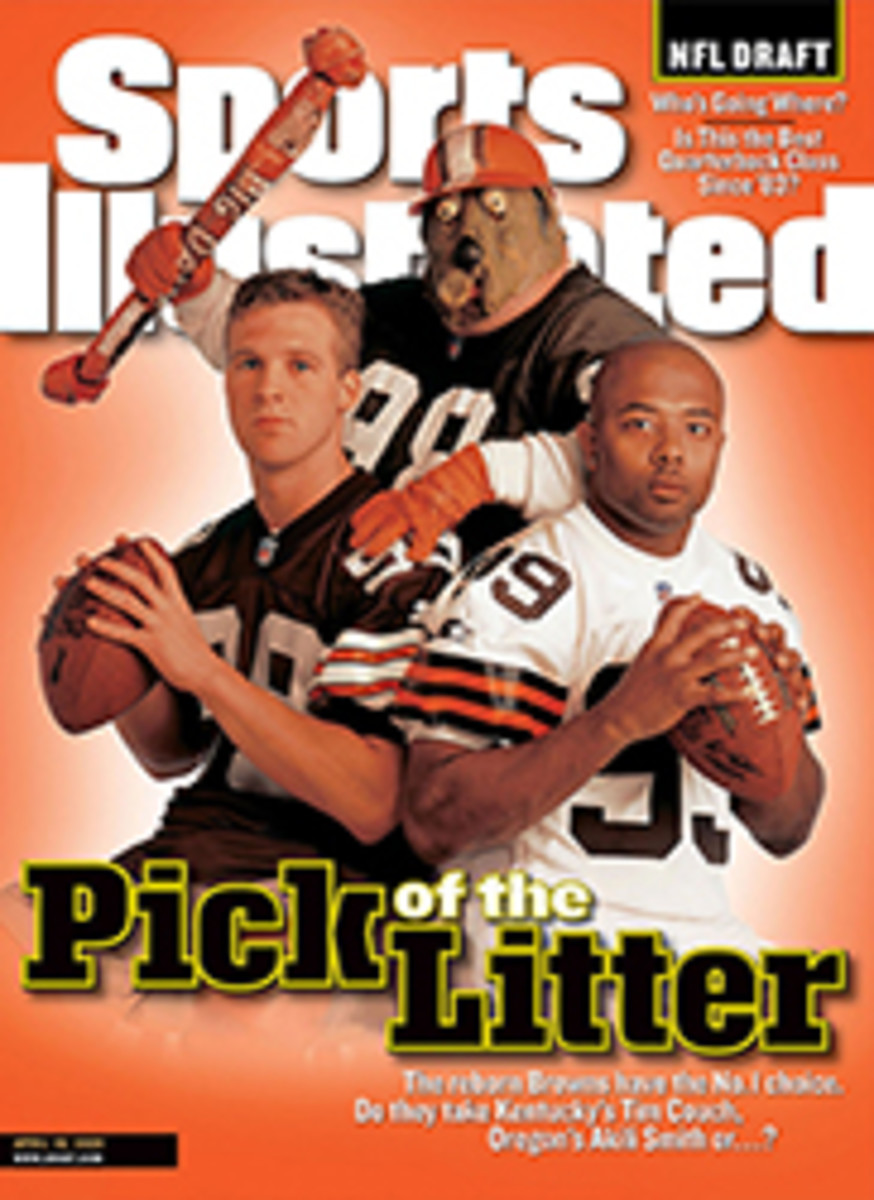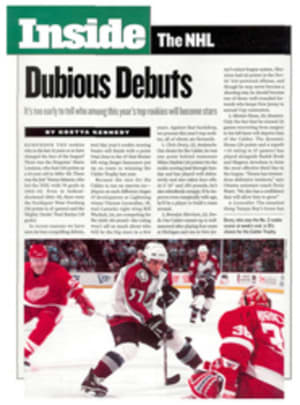
Twin Terrors The 15th and 17th holes at Augusta used to be easy. Now they've been turned into...
Somewhere, Bobby Jones and Clifford Roberts are giving two
thumbs-up to the radical alterations made to Augusta National
before this year's Masters. The decisions to grow the first
rough in tournament history, lengthen the par-5 2nd hole, raise
the green of the par-4 11th, tighten the par-5 15th and narrow
and stretch the par-4 17th were validated on Sunday afternoon as
Jose Maria Olazabal outdueled Greg Norman.
After making the most exhilarating eagle of his career, at the
13th, an energized Norman stepped to the 14th tee tied for the
lead and with the honor. He pushed his drive, and his ball,
drifting in a left-to-right wind, headed for trees. But Norman
got a break, his ball bounced off a spectator and into a
clearing 150 yards from the pin. Instead of sitting on tightly
mown fairway grass, though, as it would have in every previous
Masters, Norman's ball sank into the new, 1 3/8-inch-deep second
cut. Because of the grass between the ball and the blade of his
seven-iron, Norman was unable to apply backspin, and his
approach came out hot. It carried 10 yards farther onto the
green than he had intended and ended up on the back fringe. He
was 60 feet from the pin, with 10 feet of break. Three putts
later, Olazabal was back in front.
Then, on the 15th, Norman tried to launch what has always been
the money shot on the 500-yard hole, a hard smoker--a draw--up
the right side. Only his ball didn't turn. It landed in the
rough among newly planted 35-foot-tall pines. In a situation
where going for the green in two would, normally, have been
mandatory, Norman was forced to lay up short of the pond on a
downhill slope 98 yards from the hole. From there he terribly
pushed a wedge into a greenside bunker and made another bogey.
Goodbye, storybook ending.
Norman's drives on 14 and 15 were the kind of marginal tee shots
that players had been getting away with forever at the Masters.
The tournament's inclination to forgive wildness and reward
length and imaginatively played recovery shots has been part of
the charm that separates it from the other majors, particularly
the often plodding U.S. Open and PGA. The Masters has always
made it easier for exciting power hitters to climb the leader
board and produce big scoring swings on the back nine. But the
open spaces have also led to instances of domination by a single
great talent, such as in 1965, when Jack Nicklaus won by nine,
and in '97, when Tiger Woods came out 12 strokes ahead.
Doubtless, it was because of the abilities of Woods, David Duval
and other powerful young players that the chairman of the
Masters, William (Hootie) Johnson, implemented the changes. As
Norman and others learned, even 1 3/8 inches of rough can have a
dramatic effect, and the new Augusta National demands a higher
level of play. To win, Olazabal departed from the pyrotechnics
seen in recent Masters and played a classic championship style
of golf--the dogged avoidance of mistakes anchored by a terrific
short game.
Birdies could be made this year, as evidenced by Steve Pate's
tournament-record run of seven in a row in the third round, but
the rough was an extra element that made this Masters the most
wearing in memory for the players. On several greens it was
almost impossible to stop an approach shot close to the hole, and
par, even on the short par-5s, was a good score.
Look at the numbers. Although scoring was fractionally better
than it was last year--73.959 to 74.069--there were fewer scores
in the 60s (20) last week than in any Masters but one this
decade, in 1994 (14), when Olazabal also won. No one broke 70 in
this year's edgy final round.
In 1998 the field hit the fairway 86.1% of the time. This year,
with the fast-running landing areas reduced to less than 40
yards in most cases, that number was down to 70.2%. Of the 56
players who made the cut, no one had a round in which he hit
either all 14 fairways or all 18 greens in regulation.
Despite their difficulties, none of the players who appeared on
the leader board had any real complaints about the setup. "I
like the changes because it makes for a more complete test,"
said Woods, who hit more greens than anyone in the field (50 out
of 72) but was last in putting (126 putts) and finished 18th.
"Length will always be an asset here, but it has to be
controlled, which has become one of my strengths. I don't
consider this course Tiger-proofed."
Phil Mickelson, who led the field in subpar holes with 18
birdies and an eagle--he also had 13 bogeys and two
doubles--called this Masters "the fairest in which I've ever
played." Duval, who on Sunday played like Mickelson, making six
birdies and an eagle but shooting only two-under 70, said, "It's
more of a methodical, thinking course now. I misjudged the
effect of the rough, but I'll know better next year."
In 2000 the players will probably also have a better feel for
the 15th and 17th holes, two former cupcakes that played tough
last week, giving the Masters a new pacing. The old Augusta
could be played at full throttle after the frightening 12th. Now
the last six holes are as bogeyable as they are birdieable.
The 15th has always been the easiest hole on the course, with a
scoring average of 4.786 going into this year's tournament. Last
week it ranked as the 15th hardest hole, playing at over par
(5.027). Other than last year, when golfers played into a strong
north wind for most of the tournament, the 15th had only played
over par twice, in 1973 and '87. This year the green was hit in
regulation (two or three shots) only 63.5% of the time, the
lowest percentage ever recorded.
What happened? The green was intentionally made rock-hard so it
would reject any long shot hit without spin. Even the big
hitters, if they drove into the rough, laid up on the hole. But
what really made the 15th dangerous was the pitch from the
lay-up area. Off a tight downhill lie to the hard green, this
shot has always been one of the most demanding wedge plays in
the majors, and this year more players than ever had to hit it.
The shot undid Duval on Friday--his ball carried the pond but
rolled back into the water, leading to a triple-bogey 8--and on
Saturday knocked Davis Love III out of the lead when he dumped
his pitch into the drink.
The 17th hole, which was lengthened 25 yards to 425, had been
the 10th-hardest alltime. This year it jumped to second, with a
scoring average of 4.306. In the past the 17th green had been
hit in regulation 60% of the time. This year it was missed
exactly that often. Just like on 15, trying to hold the crowned
and baked-out 17th green from the rough was hopeless.
Once considered an uninteresting hole, 17 now ranks among
championship golf's most difficult and controversial par-4
17ths, along with the Road Hole at St. Andrews and the converted
par-5 at Olympic. "It's one of the great finishing holes," says
Raymond Floyd. "The change has rolled back the clock. The hole
is playing the way it did in the '60s. This is all about keeping
up with technology, and it's all to the good."
For now, the Masters is less of a birdiefest, but before long the
players will catch up and Woods's record of 18-under 270 will be
threatened. In the meantime the guardians of the legacy of Jones
and Roberts have proven that they know what they're doing.
COLOR PHOTO: PHOTOGRAPH BY BOB RIVES Shark repellent Norman's latest crash in the Masters included his Sunday drive into this new stand of pines on 15. Tree-mendous Putting the Eisenhower tree back in play and growing some rough helped 17 go from a cupcake to a killer.
COLOR PHOTO: ROBERT BECK Tiger-proofed The rough often frustrated Woods.
COLOR PHOTO: SIMON BRUTY Straw vote Bill Glasson and most of the players favored the changes.
The Hole Story
The verdict is in on the changes to Augusta National. According
to the numbers, the decision to lengthen the 17th hole by 25
yards had the most dramatic effect on scoring, and the addition
of 25 yards to the 2nd had the least. Here's a look at all 18
holes (the altered holes are bold-faced) and how they rank
according to difficulty.
1942-98 1998 1999
HOLE YARDS PAR AVG RANK AVG RANK AVG RANK
1 410 4 4.217 7 4.414 1 4.243 4
2[*] 575 5 4.796 17 4.772 17 4.847 16
3 350 4 4.109 14 4.190 5 4.166 9
4 205 3 3.291 3 3.261 3 3.346 1
5 435 4 4.285 4 4.149 10 4.219 5
6 180 3 3.130 13 3.243 4 3.203 T7
7 365 4 4.142 12 4.019 15 4.076 13
8 550 5 4.840 15 4.877 16 4.827 17
9 430 4 4.143 11 4.034 14 4.106 11
36.953 36.959 37.033
10 485 4 4.328 1 4.169 8 4.203 T7
11[*] 455 4 4.272 5 4.165 9 4.216 6
12 155 3 3.307 2 3.322 2 3.306 T2
13 485 5 4.798 16 4.745 18 4.615 18
14 405 4 4.190 8 4.184 6 4.086 12
15[*] 500 5 4.786 18 5.097 13 5.027 15
16 170 3 3.167 9 3.180 7 3.130 10
17[*] 425 4 4.144 10 4.109 12 4.306 T2
18 405 4 4.228 6 4.139 11 4.037 14
37.220 37.110 36.926
74.173 74.069 73.959
[*][altered hole]
"It's more of a thinking course now," Duval said. "I misjudged
the effect of the rough, but I'll know better next year."

